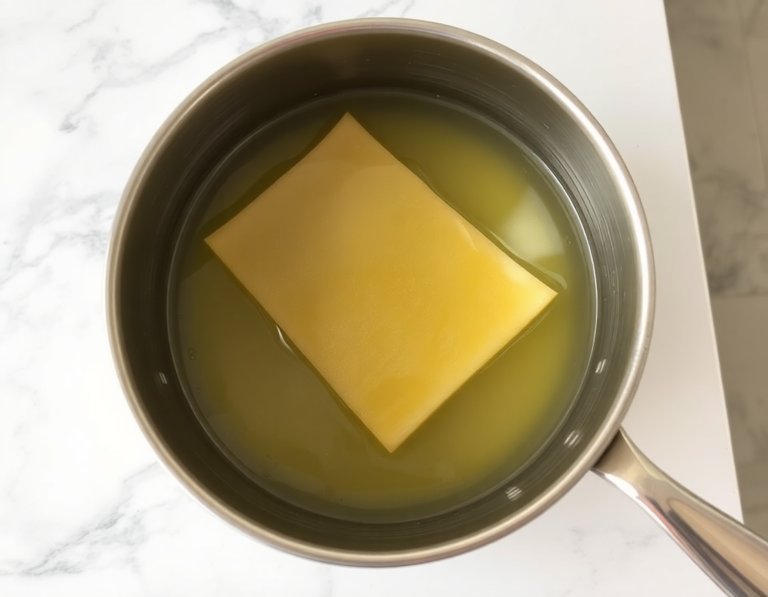There’s something about miso soup that’s like a warm hug in a bowl—comforting, savory, and just a bit mysterious. I remember trying miso soup for the first time at a little tucked-away Japanese restaurant during a rainy evening, and it was pure magic. This easy vegan version captures that cozy essence with simple ingredients, so even on the busiest days, you can whip up a bowl that takes you back to those tranquil, rainy moments.
Steps
- Prepare the Dashi: Begin by soaking a piece of kombu (dried kelp) in 4 cups of water in a saucepan. Let it sit for about 30 minutes if you have the time, then slowly heat the mixture over medium-low heat. Just before the water reaches a boil, remove the kombu to avoid bitterness, leaving you with Kombu Dashi.
- Enhance the Dashi: If you prefer a non-vegetarian version, add a cup of katsuobushi (dried bonito flakes) to the Kombu Dashi. Bring it back to a boil, then reduce the heat and let it simmer for 30 seconds before turning off the heat. Allow the bonito flakes to settle for about 10 minutes, then strain the mixture to obtain Awase Dashi.
- Dissolve the Miso Paste: Pour the prepared dashi into a saucepan and heat gently until it reaches around 205°F (96°C). Turn off the heat, place 4 tablespoons of miso paste in a ladle, and gradually mix in some of the hot dashi until the paste dissolves completely, ensuring a smooth blend.
- Add Tofu and Wakame: Cut about 7 ounces of silken tofu into ½-inch cubes and add them to the miso soup. Alongside, incorporate 1 tablespoon of dried wakame seaweed and chopped green onions, stirring gently to combine and preserve their texture and aroma.
- Serve and Store: Serve the miso soup immediately while it’s warm, ensuring it does not boil to maintain its flavor and aroma. If storing, let it cool to room temperature before refrigerating for up to 2 days, or freeze without tofu for up to 2 weeks. Reheat gently over medium heat without boiling when ready to consume.
Ingredients
- 4 cups water
- 1 piece kombu (dried kelp)
- 1 cup katsuobushi (dried bonito flakes)
- 4 tablespoons miso paste
- 7 oz soft/silken tofu, cut into ½-inch (1.3 cm) cubes
- 1 tablespoon dried wakame seaweed
- 1 green onion/scallion, chopped into thin rounds
FAQ
- What is miso soup and what are its main ingredients?
- Miso soup is a traditional Japanese dish made by mixing miso paste into dashi, a Japanese soup stock. Common ingredients include tofu, wakame seaweed, green onions, and sometimes vegetables. The soup is known for its comforting umami flavor and health benefits.
- How do you make dashi for miso soup?
- Dashi is a key component of miso soup, offering a distinctive umami taste. You can make dashi by soaking kombu (kelp) in water and heating it, then adding bonito flakes and letting them steep before straining. Alternatively, you can use a dashi packet or powder for convenience, though these methods may provide a less intense flavor.
- When should miso paste be added to the soup, and why?
- Miso paste should be added just before serving to preserve its delicate aroma and flavor. It’s important not to boil the soup after adding miso, as high temperatures can diminish its fragrance and nutritional value. Dissolve the miso in a ladle or separate bowl before mixing it into the dashi.
- How can you store miso soup, and does reheating affect its quality?
- It’s best to consume miso soup fresh, but it can be refrigerated for 3–4 days or frozen for up to 2 weeks. If freezing, remove tofu beforehand as its texture changes upon reheating. When reheating, gently warm the soup without boiling to maintain its flavor and aroma.
- Are there health benefits to consuming miso soup?
- Yes, miso soup is rich in essential nutrients like copper, manganese, protein, Vitamin K, and zinc. It’s also beneficial for bone health due to minerals like calcium and magnesium and may improve heart health with compounds like Vitamin K2 and linoleic acid.
Tips
- When making dashi, consider preparing a large batch and storing it in the refrigerator for 3-5 days or freezing it for up to two weeks. This will allow you to quickly whip up a bowl of miso soup whenever you desire.
- To preserve the delicate flavor and aroma of miso, always add the miso paste just before serving. Make sure the soup is not boiling when you add the miso, as high temperatures can degrade the taste.
- Always dissolve miso paste separately in a ladle or bowl before adding it to the soup to prevent clumping. This ensures a smooth and evenly flavored soup.
- If you plan to store miso soup for later, do so without the miso paste. Add the miso only to the portion you are about to consume to maintain the soup’s freshness and flavor.
Equipment
- Miso Muddler – This tool helps measure and dissolve miso paste effectively.
- Fine-Mesh Strainer – Useful for straining dashi and ensuring smooth miso without clumps.
- Dashi Packet – If opting for the shortcut method to make dashi.
- Dashi Powder – For the fastest preparation of dashi.
- Kombu (Dried Kelp) – Essential for making homemade dashi.
- Katsuobushi (Dried Bonito Flakes) – Used in making Awase Dashi for the soup base.

